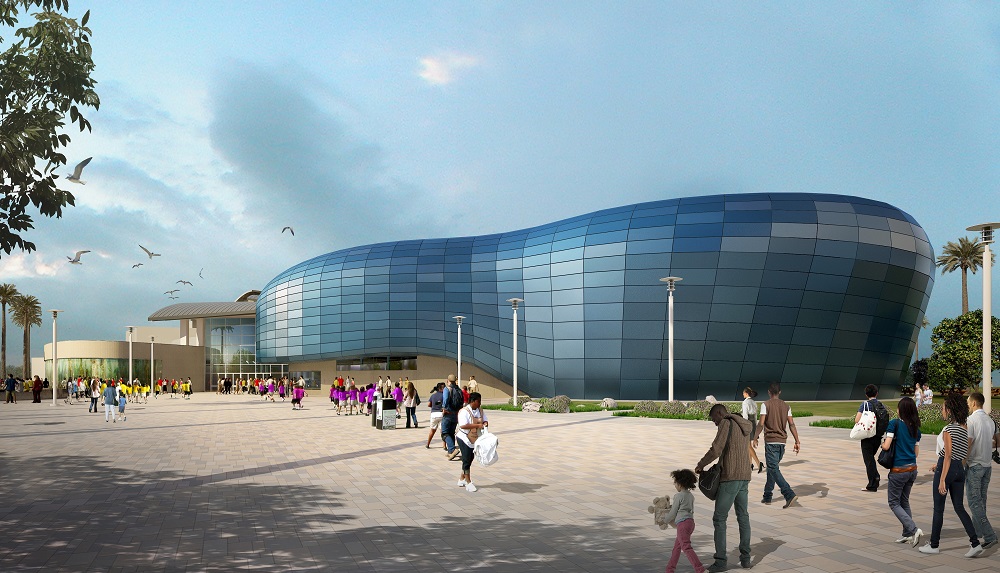The Aquarium of the Pacific’s new Pacific Visions wing has a façade made of 800 light-diffusing glass panels that changes colors throughout the day. The panels, which total 18,000 sf, also act as a ventilated rain screen.
Best yet, the smooth contours make it so that when light hits it just right, the new aquarium wing looks like a whale.
San Francisco architecture firm EHDD designed the addition to the Long Beach, Calif., aquarium. Pacific Visions, which will open in late 2018, will have a 300-seat theater with a 130-by-32-foot-tall screen, curved in a 180 degree arc. The theater will hold performances, panel discussions, community meetings, and educational seminars.
The wing will have a spacious front plaza that doubles as a community gathering space; a 6,000-sf changing exhibit gallery that has live animals and interactive displays; and an art gallery and orientation gallery.
The project cost $53 million and is the second and final phase of the Aquarium of the Pacific’s Campus Master Plan, which was adopted in 2005. The new wing will bring the aquarium’s audience capacity to more than 2 million per year.
“Pacific Visions represents an unprecedented opportunity to help our growing audience examine the vital and changing relationship between humans and the World Ocean and choose paths to make that relationship sustainable,” Dr. Jerry R. Schubel, Aquarium of the Pacific president & CEO, said in a statement. “We want our visitors to leave Pacific Visions feeling more deeply engaged with the living ocean, knowledgeable about the challenges that face it and us, and empowered to make better decisions and share their new understanding with others.”
Related Stories
| Aug 11, 2010
Museum celebrates African-American heritage
The Harvey B. Gantt Center for African-American Arts + Culture recently completed construction on the Wells Fargo Cultural Campus in Charlotte, N.C. Designed by the Freelon Group, Durham, N.C., with Batson-Cook's Atlanta office as project manager, the $18.8 million project achieved nearly 100% minority participation.
| Aug 11, 2010
Design for Miami Art Museum triples gallery space
Herzog & de Meuron has completed design development for the Miami Art Museum’s new complex, which will anchor the city’s 29-acre Museum Park, overlooking Biscayne Bay. At 120,000 sf with 32,000 sf of gallery space, the three-story museum will be three times larger than the current facility.
| Aug 11, 2010
Thom Mayne unveils ‘floating cube’ design for the Perot Museum of Nature and Science
Calling it a “living educational tool featuring architecture inspired by nature and science,” Pritzker Prize Laureate Thom Mayne unveiled the schematic designs and building model for the Perot Museum of Nature & Science at Victory Park in Dallas. The $185 million, 180,000-sf structure is 170 feet tall—equivalent to approximately 14 stories—and is conceived as a large...
| Aug 11, 2010
Piano's 'Flying Carpet'
Italian architect Renzo Piano refers to his $294 million, 264,000-sf Modern Wing of the Art Institute of Chicago as a “temple of light.” That's all well and good, but how did Piano and the engineers from London-based Arup create an almost entirely naturally lit interior while still protecting the priceless works of art in the Institute's third-floor galleries from dangerous ultravio...
| Aug 11, 2010
The Art of Reconstruction
The Old Patent Office Building in Washington, D.C., completed in 1867, houses two Smithsonian Institution museums—the National Portrait Gallery and the American Art Museum. Collections include portraits of all U.S. presidents, along with paintings, sculptures, prints, and drawings of numerous historic figures from American history, and the works of more than 7,000 American artists.
| Aug 11, 2010
Silver Award: Please Touch Museum at Memorial Hall Philadelphia, Pa.
Built in 1875 to serve as the art gallery for the Centennial International Exhibition in Fairmount Park, Memorial Hall stands as one of the great civic structures in Philadelphia. The neoclassical building, designed by Fairmount Park Commission engineer Hermann J. Schwarzmann, was one of the first buildings in America to be designed according to the principles of the Beaux Arts movement.







